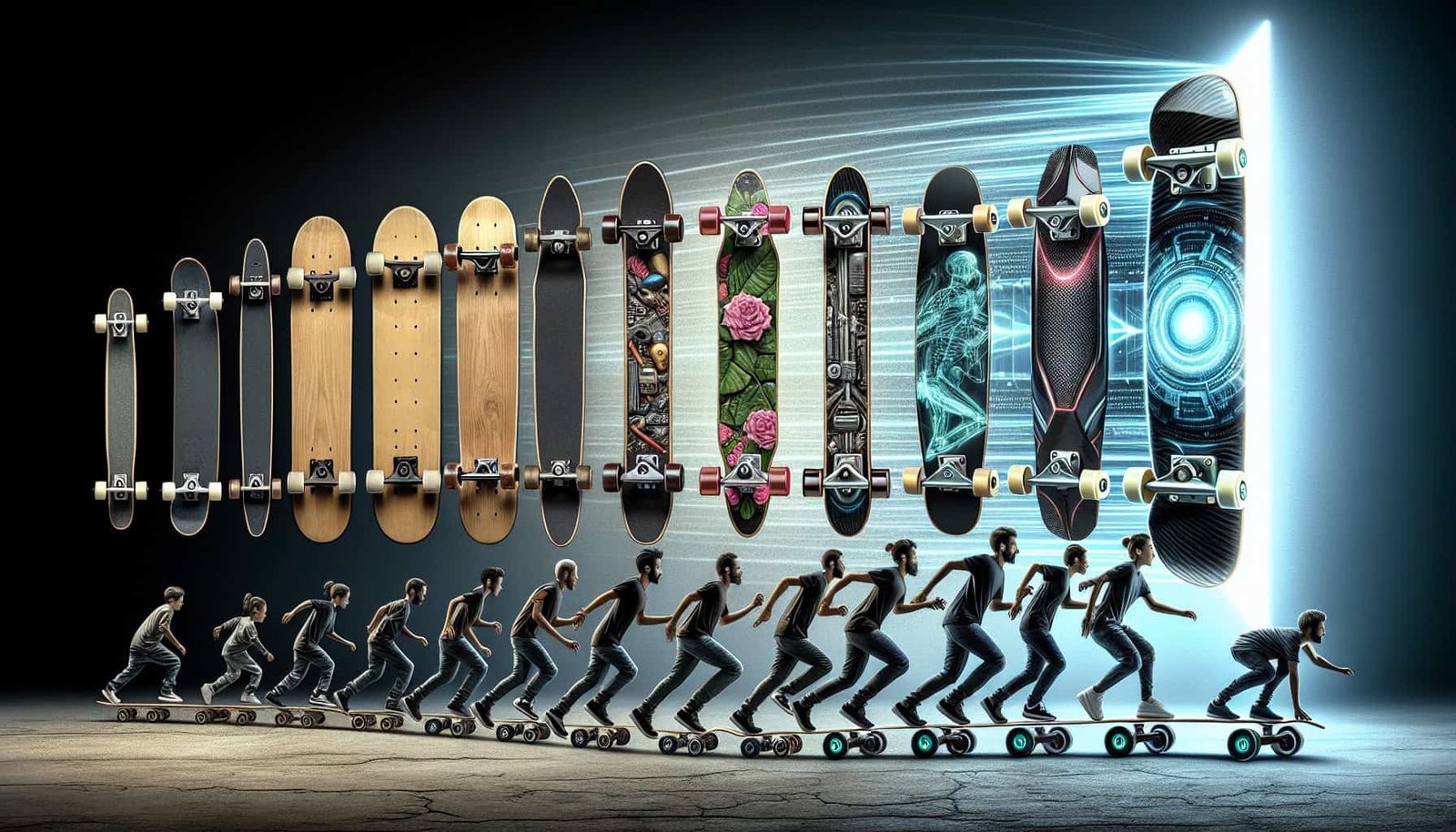Skateboarding has come a long way since its humble beginnings, and the advancements in technology have played a significant role in shaping the sport into what it is today. From improved skateboard designs to cutting-edge equipment, these technological advancements have revolutionized the way skaters perform tricks, ride, and push the boundaries of the sport. But have you ever wondered about the true impact these advancements have had on skateboarding? In this article, we will explore the various ways in which technology has influenced the sport, from enhancing performance to fostering creativity and pushing the limits of what is possible on a skateboard. So, grab your board and get ready to embark on a thrilling journey into the world of skateboarding technology!
Lightweight and Durable Skateboard Decks
Introduction of Composite Materials
Skateboard decks have come a long way since the early days of solid wood construction. The introduction of composite materials revolutionized the industry by offering skateboarders a lighter and more durable alternative. Composite materials, such as fiberglass and carbon fiber, have gained popularity due to their strength-to-weight ratio. These materials allow for the creation of thinner and lighter decks without compromising on durability.
Increase in Popularity of Carbon Fiber Decks
Among the various composite materials used in skateboard decks, carbon fiber has emerged as a favorite among professional and amateur skateboarders alike. Carbon fiber decks offer a unique combination of strength, stiffness, and lightweight. This allows skaters to perform tricks with greater ease and agility. The increased popularity of carbon fiber decks is a testament to their superior performance characteristics and the positive impact they have had on the sport of skateboarding.
Impact on Skateboarding Performance
The introduction of lightweight and durable skateboard decks has had a significant impact on skateboarding performance. Skaters are now able to achieve higher levels of precision and control in their tricks, thanks to the reduced weight and increased responsiveness of composite decks. Additionally, the enhanced durability of these decks allows skaters to push their limits and attempt more challenging tricks without fear of the deck breaking or losing its integrity. The advancements in skateboard deck technology have undoubtedly raised the bar for what is possible in the sport, pushing skaters to new heights of creativity and technicality.
Evolution of Skateboard Trucks

Introduction of Aluminum Trucks
Skateboard trucks are an essential component that connects the deck to the wheels, allowing for maneuverability and stability. In the early days of skateboarding, trucks were primarily made of steel, which provided the necessary strength but often added extra weight to the skateboard. The introduction of aluminum trucks revolutionized the industry by offering a lighter alternative without compromising strength or stability. Aluminum trucks quickly gained popularity among skaters, allowing for more precise maneuverability and increased overall performance.
Impact on Maneuverability and Stability
The introduction of aluminum trucks had a profound impact on skateboard maneuverability and stability. The lighter weight of aluminum trucks made it easier for skaters to initiate turns and execute tricks that required quick and precise movements. Additionally, aluminum trucks provide a more responsive ride, allowing skaters to navigate through tight spaces and make split-second adjustments with ease. The increased maneuverability and stability provided by aluminum trucks opened up new possibilities for skaters, enabling them to explore more complex and technical aspects of the sport.
Transition to Hollow and Titanium Trucks
The evolution of skateboard trucks didn’t stop at aluminum. Over time, advancements in technology led to the development of hollow and titanium trucks. Hollow trucks are created by removing excess material from the inside of the truck, resulting in a lighter overall weight. This reduction in weight enhances maneuverability and allows for greater responsiveness. Titanium trucks, on the other hand, offer superior strength-to-weight ratio compared to traditional aluminum trucks, further enhancing the performance capabilities of skateboarders. The transition to hollow and titanium trucks is yet another example of how technological advancements have continuously pushed the boundaries of what is possible in skateboarding.
Impact of Skateboard Wheels Innovations
Introduction of Polyurethane Wheels
Skateboard wheels have undergone significant advancements over the years, with one of the most game-changing being the introduction of polyurethane wheels. Prior to polyurethane, wheels were typically made of hard plastic or clay, which resulted in a rough and noisy ride. Polyurethane wheels revolutionized skateboarding by providing a smoother and quieter ride, as well as increased grip and durability.
Development of Different Shapes and Durometers
As skateboarding progressed, the development of different wheel shapes and durometers allowed skateboarders to tailor their setups to their specific riding styles and preferences. Different wheel shapes, such as square-edged or rounded, have varying levels of grip and slide characteristics, allowing skaters to excel in different types of skateboarding disciplines. Durometer refers to the hardness of the wheel, with higher durometer wheels providing a harder and faster ride, while lower durometer wheels offer more grip and a smoother ride. This diversity in wheel options has greatly impacted skateboarding, enabling skaters to optimize their performance and enhance their overall experience.
Impact on Grip, Speed, and Smoothness
The innovations in skateboard wheel technology have had a profound impact on grip, speed, and smoothness of the ride. Polyurethane wheels offer superior grip, allowing skaters to maintain control during tricks and maneuvers. The smoother ride provided by polyurethane wheels reduces vibrations and makes for a more comfortable experience, especially when riding over rough terrain. Additionally, the speed capabilities of skateboard wheels have increased significantly, allowing skaters to reach higher velocities and execute tricks with greater speed and fluidity. These advancements in wheel technology have undoubtedly enhanced the overall performance and enjoyment of skateboarding.
Bearings and the Speed Revolution

Introduction of High-Quality Bearings
Skateboard bearings are small, metal components that sit inside the skateboard wheels and allow them to spin freely. The introduction of high-quality bearings revolutionized the sport of skateboarding by significantly improving speed and performance. Prior to the development of high-quality bearings, skateboarders often had to contend with slow and inefficient rides. With the introduction of precision bearings, skaters could maximize their speed potential and execute tricks with greater ease.
Advancements in Ceramic Bearings
Ceramic bearings represent the pinnacle of skateboard bearing technology. Made from ceramic materials, these bearings offer unparalleled smoothness and high-speed performance. Ceramic bearings are known for their ability to resist heat and friction, resulting in reduced wear and tear. The use of ceramic materials also reduces the weight of the bearings, further enhancing skateboarder’s performance capabilities.
Influence on Speed and Longevity
The advancements in bearing technology have had a significant influence on the speed and longevity of skateboarding. High-quality bearings provide skaters with faster rides, allowing them to effortlessly cover more ground and execute tricks with greater precision and speed. The durability and resilience of modern bearings also contribute to their longevity, reducing the need for frequent replacements and enhancing the overall performance and cost-effectiveness of skateboarding.
Role of Grip Tape in Skateboarding

Evolution of Griptape Materials
Griptape is the rough, sandpaper-like material that covers the top surface of the skateboard deck, providing traction and grip for the skater’s feet. Over the years, griptape has evolved from coarse sandpaper to more advanced materials like silicone carbide and other synthetic blends. These advancements in materials have improved the durability and grip of griptape, ensuring that skaters can maintain maximum control over their boards.
Impact on Foot Grip and Board Control
The evolution of griptape materials has had a significant impact on foot grip and board control in skateboarding. The coarse texture of modern griptape provides enhanced traction, allowing skaters to secure their feet firmly on the board, even during high-impact maneuvers. This improved foot grip translates to better board control, enabling skaters to execute tricks with greater precision and confidence. Griptape advancements have undoubtedly played a crucial role in the progression of skateboarding, ensuring that skaters can push their skills to new limits while maintaining a strong connection to their boards.
Introduction of Clear and Graphic Griptapes
In recent years, the introduction of clear and graphic griptapes has added a new dimension to skateboard aesthetics. Clear griptapes allow skaters to showcase the graphics and artwork on their decks, providing a visually appealing look while still maintaining functionality. Graphic griptapes, on the other hand, offer skateboarders the opportunity to personalize their decks and express their individuality through custom designs and artwork. These advancements in griptape options have further enhanced the creative and self-expression aspects of skateboarding.
Impact of Skateboarding Shoe Technology

Introduction of Skate-Specific Shoes
Skateboarding shoes have undergone significant advancements to meet the specific demands of the sport. In the past, skateboarders often wore regular sneakers, which lacked the necessary features to withstand the rigors of skateboarding. With the introduction of skate-specific shoes, skateboarders gained footwear designed with reinforced toe caps, extra padding, and improved support. Skate-specific shoes are built to withstand the harsh impact and abrasion associated with skateboarding, providing skaters with the necessary protection and comfort.
Development of Innovative Footwear Features
Skateboarding shoe technology has evolved to include various innovative features aimed at improving performance and durability. These features include vulcanized or cupsole construction, which offer different levels of flexibility and board feel. Additionally, improved cushioning systems provide shock absorption, minimizing the impact on the skateboarder’s feet and joints. Furthermore, advancements in material technology have resulted in increased durability and breathability, allowing skaters to perform at their best for longer periods.
Influence on Comfort, Durability, and Board Feel
The advancements in skateboarding shoe technology have had a significant influence on comfort, durability, and board feel. Skate-specific shoes provide enhanced padding and support, preventing foot fatigue and reducing the risk of injuries. The durability of skateboarding shoes ensures that they can withstand the constant abuse from grip tape and rough surfaces. Additionally, the improved board feel provided by skate-specific shoes allows skaters to have a better sense of control and responsiveness, providing a more intuitive connection between their feet and the skateboard. These advancements in shoe technology have undoubtedly elevated the performance and overall experience for skateboarders.
Protective Gear Advancements
Introduction of Impact-Resistant Helmets
Safety has always been a critical concern in skateboarding, and advancements in protective gear have played a vital role in mitigating the risk of injuries. The introduction of impact-resistant helmets has significantly improved head protection for skateboarders. These helmets are designed to absorb and distribute the force of impact, reducing the risk of head injuries. The use of impact-resistant helmets has become increasingly prevalent, ensuring that skateboarders can enjoy the sport with added peace of mind.
Evolution of Protective Pads and Guards
In addition to helmets, advancements in protective gear have also been made in the form of pads and guards. Elbow pads, knee pads, and wrist guards are now widely available, providing skateboarders with additional protection for their vulnerable joints. These protective gears are often constructed using impact-resistant materials and feature ergonomic designs for maximum comfort and flexibility. The evolution of protective pads and guards has contributed to a safer skateboarding experience, enabling skaters to push their limits while minimizing the risk of serious injuries.
Influence on Safety and Confidence
The advancements in protective gear have had a profound influence on safety and confidence in skateboarding. The use of impact-resistant helmets and protective pads significantly reduces the risk of head and joint injuries, instilling confidence in skateboarders to push themselves and attempt more challenging tricks. This increased safety allows skaters to focus on their performance and progression without the fear of severe consequences. With the help of advanced protective gear, skateboarders can enjoy the sport to its fullest while maintaining a high level of safety.
Integration of Technology in Skateboarding
Introduction of Electric Skateboards
The integration of technology into skateboarding has seen the introduction of electric skateboards. Electric skateboards utilize battery-powered motors to propel riders, providing an alternative mode of transportation and an exhilarating experience. These electric skateboards come with various features such as regenerative braking, wireless remote controls, and different speed modes. They offer skateboarders a new way to explore their surroundings and access locations that were previously out of reach. They have gained popularity among commuters, casual riders, and even professional skateboarders due to their convenience and exciting possibilities.
Impact of Electric Skateboard Technology
The impact of electric skateboard technology can be seen in its ability to revolutionize commuting and transportation. Electric skateboards offer an eco-friendly alternative to traditional transportation methods, reducing the reliance on fossil fuels and minimizing carbon emissions. The convenience and agility of electric skateboards also allow riders to navigate through urban environments with ease, avoiding traffic congestion and reducing commute times. Furthermore, electric skateboards have opened up new possibilities in terms of distance covered and exploration, making it easier for riders to travel longer distances and discover new skate spots.
Rising Popularity of Skateboard Apps and Wearables
Along with the integration of technology in skateboard hardware, the rise of skateboard apps and wearables has had a significant impact on the sport. Skateboard apps provide skateboarders with an easy way to track their progress, log their sessions, and connect with other skateboarders in their community. These apps track key metrics such as speed, distance, and tricks performed, allowing skaters to analyze their performance and set goals for improvement. Wearable technology, such as smartwatches and fitness trackers, also contribute to the overall skateboarding experience by providing real-time data and insights. The rising popularity of skateboard apps and wearables has transformed how skateboarders engage with the sport, enhancing their overall enjoyment and progression.
Impact of Video and Social Media
Growth of Skateboarding Content Online
The advent of video sharing platforms and social media has revolutionized the way skateboarding is consumed and shared with the world. Skateboarders now have the ability to capture their tricks and performances on video and share them instantly to a global audience. This ease of sharing has led to a massive growth in skateboarding content online, with skate videos, tutorials, and competitions gaining millions of views and followers. The accessibility of skateboarding content online has played a significant role in broadening the exposure and popularity of the sport, reaching audiences far beyond traditional skateboarding communities.
Influence on Skill Progression and Exposure
The impact of video and social media on skateboarding cannot be overstated. Skateboarders now have access to a vast library of tricks and tutorials, allowing them to learn from and be inspired by other skaters from around the world. The ability to watch and analyze professional performances has significantly accelerated skill progression, pushing skateboarders to develop new tricks and push the boundaries of what is possible. Additionally, the exposure gained through sharing videos on social media platforms provides skateboarders with opportunities for recognition and sponsorship, further fueling their drive to excel in the sport.
Opportunities for Sponsorship and Branding
The rise of video and social media in skateboarding has created new opportunities for skateboarders to gain sponsorship and build personal brands. Skateboarding companies and brands now actively seek out talented skateboarders with a significant online presence, offering sponsorship deals and endorsement opportunities. Skaters with a strong social media following or viral skate videos can attract the attention of major brands, leading to collaborations, signature products, and even financial support. The ability to monetize their passion for skateboarding through sponsorships and branding has provided skateboarders with additional avenues for career advancement and financial independence.
Future of Skateboarding Technology
Anticipated Technological Advancements
The future of skateboarding technology holds exciting possibilities for further innovation. Anticipated advancements include the continued development of lightweight and sustainable materials for skateboard decks, further enhancing performance while minimizing environmental impact. In terms of trucks, advancements in materials and design may allow for even greater maneuverability and stability. Wheel technology may see improvements in grip, speed, and durability, catering to the evolving needs of skateboarders. Furthermore, advancements in protective gear and safety technologies are expected to further reduce the risk of injuries in skateboarding.
Potential Impacts on Performance and Accessibility
As skateboarding technology continues to evolve, the potential impacts on performance and accessibility are vast. Further innovations in skateboard hardware can lead to enhanced performance capabilities, allowing skateboarders to push their skills to even greater heights. Additionally, improvements in safety gear can make skateboarding more accessible to a wider range of individuals, providing a safer and more inclusive environment for all. The continued focus on performance and accessibility in skateboarding technology ensures that the sport will continue to evolve and attract new participants for years to come.
Balancing Tradition and Innovation
While advancements in skateboarding technology are exciting, it is crucial to strike a balance between tradition and innovation. Skateboarding has a rich history and culture that should be respected and preserved. The embrace of new technologies should not come at the expense of losing the core essence of skateboarding. It is essential to find harmony between technological advancements and the creative expression, self-discovery, and community that skateboarding has always been known for. By striking this balance, the future of skateboarding technology can coexist with the timeless spirit of the sport, ensuring its longevity and continued relevance.
In conclusion, the impact of skateboarding technology advancements on the sport cannot be overstated. From lightweight and durable decks to high-performance bearings and innovative protective gear, each aspect of skateboarding technology has contributed to the progression and enjoyment of the sport. With the integration of technology in electric skateboards, apps, and wearables, skateboarding has experienced a new wave of possibilities and connectivity. The growth of skateboarding content online and opportunities for sponsorship and branding have further propelled the sport into the mainstream. As we look towards the future, the anticipated technological advancements will continue to shape the performance, accessibility, and safety of skateboarding while preserving the rich tradition and spirit of the sport. Skateboarding technology is constantly evolving, paving the way for skateboarders to explore new horizons and push the boundaries of what is possible.


